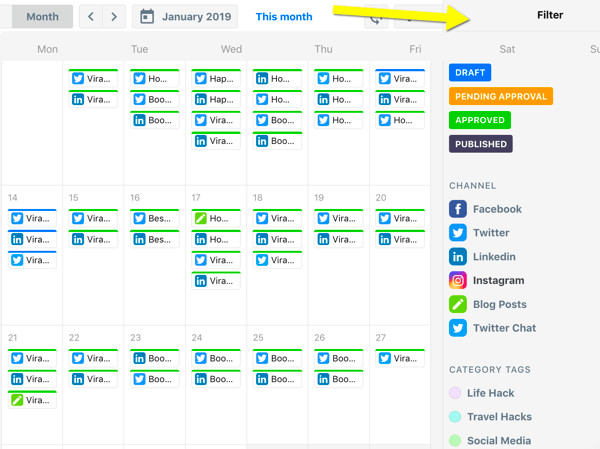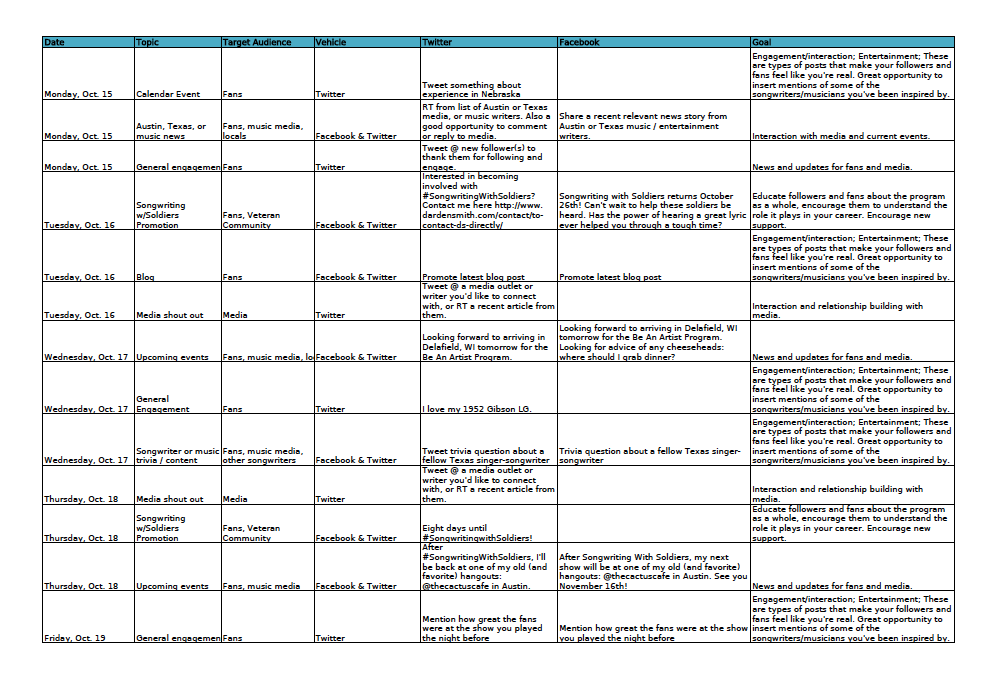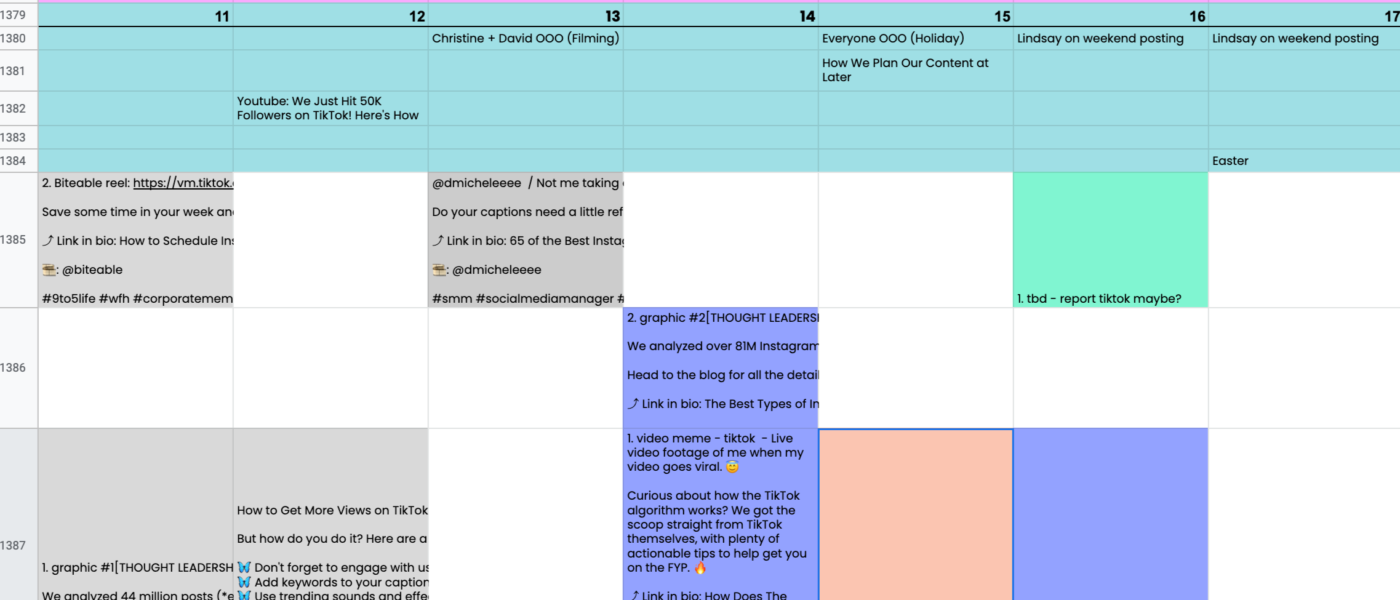Best Way to Organize Social Media Content: Streamline Success
The best way to organize social media content is by creating a content calendar and categorizing posts. By setting clear goals and using a scheduling tool, you can streamline your workflow and ensure consistency in posting.
Understanding your audience and performing competitive analysis are key steps in developing an effective content creation plan. By utilizing tools such as a content bank and content buckets, you can efficiently manage your social media content and post with purpose.
Stay organized by creating a calendar, filling it with ideas, and evaluating the performance of your content regularly. Let’s explore some effective strategies for optimizing your social media content organization.
Introduction To Social Media Content Organization
Discover the optimal approach to organizing social media content effectively. Learn about creating a content calendar, categorizing content, and leveraging tools for seamless content management across platforms. Streamline your social media strategy for improved engagement and results.
The Importance Of Organization
Social media content organization is a fundamental aspect of any successful digital marketing strategy. With the rapid growth of social media platforms, businesses and individuals are continuously generating and sharing content. As a result, the need to effectively organize and manage this content has become increasingly critical. Proper organization not only enhances efficiency but also contributes to the overall effectiveness of a social media marketing plan.
Organizing social media content allows for better planning, execution, and analysis, leading to improved engagement, brand visibility, and ultimately, conversions.
Key Benefits Of A Streamlined Approach
Implementing a streamlined approach to organizing social media content offers numerous benefits that can significantly impact the success of digital marketing efforts.
- Enhanced Consistency: A streamlined approach facilitates the consistent delivery of content, reinforcing brand identity and messaging across various social media platforms.
- Improved Time Management: By organizing content in advance, time can be utilized more efficiently, enabling marketers to focus on other critical aspects of their strategy.
- Better Audience Engagement: Organized content allows for a more strategic and targeted approach, leading to increased audience engagement and interaction.
- Simplified Analysis and Optimization: With a well-organized content structure, it becomes easier to analyze performance metrics and optimize future content based on valuable insights.
Assessing Your Social Media Landscape
Conducting a content audit: Review all existing social media channels and content to determine what is working and what needs improvement.
Setting achievable goals: Define clear objectives for your social media strategy to ensure effective content organization.
Conducting A Content Audit
Start by examining your current social media platforms and content to identify strengths and weaknesses.
Assess engagement levels, content performance, and audience demographics to gain insights.
Setting Achievable Goals
- Define specific, measurable goals that align with your overall social media objectives.
- Establish timelines and key performance indicators to track progress and success.
Understanding Content Types
When organizing social media content, it’s crucial to understand the different content types that resonate with your audience. Matching the right content to the right audience needs can significantly enhance engagement and interaction on social platforms. Here are the key content types to consider:
Educate
Educational content is designed to inform and teach your audience about relevant topics, industry trends, or helpful tips and tricks. It aims to provide value and knowledge, positioning your brand as an authority in your niche. This type of content often includes how-to guides, tutorials, and informative blog posts.
Inspire
Inspirational content is intended to motivate and uplift your audience. It often includes success stories, quotes, and personal anecdotes that resonate with the emotions and aspirations of your followers. Inspirational content can foster a strong emotional connection with your brand.
Entertain
Entertaining content aims to captivate and amuse your audience. This type of content includes memes, jokes, behind-the-scenes glimpses, and interactive posts that encourage participation. Entertaining content helps humanize your brand and create a more relatable image.
Sell
Promotional content is focused on showcasing your products or services while highlighting their unique selling points. It includes product features, special offers, and promotional campaigns. This content aims to drive conversions and sales while creating a sense of urgency and exclusivity.
Creating A Content Calendar
Organizing social media content effectively involves creating a content calendar. This tool helps in planning and scheduling posts, ensuring consistency and strategic alignment with business goals. By structuring content in advance, brands can maintain a cohesive online presence and engage their audience consistently.
Creating a Content Calendar is a crucial step in organizing your social media content. It helps you plan ahead and ensure that your content is consistent and aligned with your brand’s goals and messaging. By having a calendar, you can easily visualize your content schedule and avoid missing important dates or events. Here are the steps to develop a calendar and the tools you can use to manage it effectively.Steps To Develop A Calendar
1. Define your goals: Start by setting your social media goals, such as increasing brand awareness, driving traffic to your website, or boosting engagement. Your goals will help you determine the type of content you need to create and the frequency of your posts. 2. Research your audience: Study your audience to understand their preferences, interests, and behaviors. This will help you create relevant and engaging content that resonates with them. 3. Gather content: Collect ideas for content from different sources, such as your blog, industry news, customer feedback, and social media trends. Use a content bank or a spreadsheet to keep track of your ideas. 4. Create a content creation plan: Develop a plan for creating your content, including the topics, formats, and deadlines. You can use a content bucket strategy to categorize your content into different themes or types. 5. Build your calendar: Use a calendar tool, such as Google Calendar or Trello, to create your social media calendar. Assign each post to a specific date and time, and include the copy, visuals, hashtags, and links. Make sure to balance your content mix and avoid over-promoting your products or services. 6. Evaluate your content: Monitor the performance of your content and adjust your strategy accordingly. Use analytics tools, such as Google Analytics or Sprout Social, to track your metrics, such as reach, engagement, and conversions.Tools For Calendar Management
There are many tools available to help you manage your social media calendar effectively. Here are some popular options:- Google Calendar: A free and easy-to-use calendar tool that allows you to create and share calendars with your team. You can also set reminders and sync your calendar with other apps.
- Trello: A project management tool that enables you to create boards, lists, and cards for your social media tasks. You can use it to collaborate with your team and track your progress.
- Hootsuite: A social media management platform that allows you to schedule and publish your posts across multiple channels. You can also monitor and analyze your social media performance.
- Buffer: A social media scheduling tool that enables you to plan and publish your posts on different platforms. You can also collaborate with your team and analyze your results.
- Sprout Social: A social media analytics and management tool that provides you with insights into your audience, content, and performance. You can use it to schedule, publish, and analyze your posts.
Social Media Content Categorization
Organizing social media content involves categorizing posts by theme, purpose, or format to streamline content creation and scheduling. By grouping content into categories, such as promotional, educational, or entertaining, marketers can ensure a balanced and effective social media strategy. This approach also facilitates easier content planning and audience engagement.
Social media content categorization is an essential aspect of organizing your social media content efficiently. By organizing your content, you can easily find and publish the right content at the right time, leading to better engagement and increased reach. The four main content categories that you can use to organize your social media content include promotional, educational, entertaining, and inspiring content. These categories represent the different types of content that you can use to engage your audience on social media. To efficiently categorize your social media content, you can use several techniques. Firstly, you can use tags to classify content based on the content type, industry, or topic. You can also use labels to categorize content based on the stages of the buyer’s journey, such as awareness, consideration, and decision-making stages. Additionally, you can use folders or boards to organize content based on specific campaigns or themes. HTML Syntax:Four Main Content Categories
- Promotional content
- Educational content
- Entertaining content
- Inspiring content
Techniques For Efficient Categorization
To efficiently categorize your social media content, you can use several techniques:
- Tags to classify content based on the content type, industry, or topic.
- Labels to categorize content based on the stages of the buyer’s journey, such as awareness, consideration, and decision-making stages.
- Folders or boards to organize content based on specific campaigns or themes.
Content Creation Strategies
Discover the best way to organize social media content with effective content creation strategies. Learn to create a content calendar, categorize posts, and develop a posting schedule for improved organization and engagement. Unlock your true social media potential with these expert tips.
Developing A Content Plan
When it comes to organizing social media content, developing a content plan is essential for creating a cohesive and effective strategy. A well-thought-out plan helps in maintaining consistency and relevance across various social media platforms.
Here are some key steps to consider when developing a content plan:
- Understand Your Audience: Analyze your target audience to create content that resonates with them.
- Set Clear Goals: Define specific objectives for your social media content to guide your strategy.
- Perform Competitive Analysis: Study your competitors’ content to identify opportunities and differentiate your approach.
- Gather Content: Collect relevant and engaging content, including visuals, articles, and user-generated posts.
- Create a Calendar: Establish a content calendar to schedule posts and maintain a consistent publishing frequency.
- Evaluate Content: Regularly assess the performance of your content to refine your strategy and optimize results.
Maintaining A Content Bank
Another crucial aspect of organizing social media content is maintaining a content bank, which serves as a repository for storing and categorizing valuable content resources. Here’s how to effectively manage a content bank:
- Content Categorization: Organize your content bank into categories or themes to facilitate easy retrieval and utilization.
- Utilize Content Buckets: Group content based on themes, such as educational, promotional, behind-the-scenes, and user-generated, to diversify your posting approach.
- Collaboration with Team: Utilize collaboration tools like Evernote to streamline content creation and ensure seamless team collaboration.
Tools And Tech For Organization
When it comes to organizing social media content effectively, utilizing the right tools and technology is crucial for streamlining processes and maximizing efficiency.
Choosing The Right Scheduling Tools
- Social Media Planner: Efficiently plan and automate marketing processes with a smart calendar.
- Brandfolder: Streamline workflow by storing and sharing media assets from a centralized location.
- Loomly: Optimize social media planning with a comprehensive tool for content organization.
Leveraging Software For Team Collaboration
- Brandwatch: Unlock social media potential and enhance collaboration within your team.
- Sprout Social: Drive business impact through intuitive social media planning tools and analytics.

Credit: www.socialmediaexaminer.com
Scheduling And Posting
When it comes to organizing social media content, scheduling and posting play a crucial role in maintaining a consistent and engaging online presence. Effectively scheduling and posting your content not only saves time but also ensures that your audience receives valuable and timely updates. Let’s delve into the best practices for scheduling and posting social media content.
How To Schedule Effectively
Scheduling your social media content is essential for maintaining a consistent posting frequency and reaching your target audience at the right times. To schedule effectively:
- Understand your audience: Identify the peak times when your audience is most active on social media platforms.
- Utilize scheduling tools: Leverage social media management tools such as Hootsuite, Buffer, or Sprout Social to schedule posts in advance across multiple platforms.
- Batch content creation: Dedicate specific time slots for creating and scheduling content in batches, allowing for better organization and efficiency.
- Consistent posting: Maintain a consistent posting schedule to keep your audience engaged and informed about your brand’s activities.
Best Practices For Posting
Posting your content on social media requires strategic planning and execution to maximize engagement and reach. Consider the following best practices:
- Quality over quantity: Focus on creating high-quality, relevant content that resonates with your audience rather than posting frequently without value.
- Engage with your audience: Encourage discussions, respond to comments, and interact with your followers to build a strong community around your brand.
- Use multimedia content: Incorporate a mix of visual and interactive content such as videos, infographics, and polls to captivate your audience’s attention.
- Monitor performance: Regularly analyze the performance of your posts to understand what resonates with your audience and adjust your posting strategy accordingly.
Tracking And Analytics
When it comes to organizing social media content, tracking and analytics play a crucial role in ensuring that your strategy is effective and yielding the desired results. By evaluating content performance and using analytics to inform strategy, you can optimize your social media efforts for better engagement and results.
Evaluating Content Performance
Evaluating content performance is essential for understanding what resonates with your audience and what doesn’t. By analyzing metrics such as reach, engagement, and conversion rates, you can identify the types of content that are most effective in achieving your goals. This data-driven approach allows you to refine your content strategy and focus on producing the most impactful social media content.
Using Analytics To Inform Strategy
Using analytics to inform strategy involves leveraging data to make informed decisions about your social media content. By tracking key performance indicators (KPIs) and analyzing trends, you can gain valuable insights into your audience’s preferences and behaviors. This information can then be used to tailor your content strategy, refine your messaging, and optimize the timing of your posts for maximum impact.

Credit: m.youtube.com
Maintaining Organization
Effectively organizing social media content involves creating a content calendar, categorizing posts, setting goals, and utilizing a scheduling tool. By structuring content strategically, you can optimize engagement and streamline your social media workflow for better results.
Inbox Zero Mentality For Social
Incorporate an Inbox Zero mentality to stay on top of social media messages efficiently.Organizational Tips For Content Management
Implement these organizational tips for effective content management:- Utilize content calendars to schedule posts
- Categorize content into relevant themes or topics
- Regularly audit and analyze social media performance
- Engage with your audience through comments and messages
Promoting Your Content
After meticulously organizing your social media content, the next crucial step is promoting it effectively to reach your target audience. This involves utilizing various strategies to ensure maximum visibility and engagement.
Creating Forms For Social Promotion
One effective way to streamline your social promotion efforts is by creating forms that capture essential information for each promotion campaign. These forms can include details such as the target audience, messaging, visuals, and desired outcomes. By having a structured form in place, you can ensure consistency and efficiency in your promotional activities.
Strategies For Engaging Promotion
Engaging promotion strategies are key to capturing the interest of your audience and driving meaningful interactions. Some effective strategies include:
- Utilizing eye-catching visuals and compelling copy to grab attention
- Running contests or giveaways to incentivize engagement
- Collaborating with influencers or partners to extend your reach
- Engaging directly with your audience through polls, Q&A sessions, or live videos
By incorporating these engaging promotion strategies into your social media content plan, you can create a buzz around your brand and encourage active participation from your followers.

Credit: atomicinteractive.com
Frequently Asked Questions
How To Structure Your Social Media Content?
To structure your social media content, first learn about your audience and set clear goals. Conduct competitive analysis and gather content, then develop a content creation plan. Create a calendar, evaluate content, and organize and schedule your posts. Finally, track your social media performance to make improvements.
How Do You Organize Your Social Media Content?
To organize social media content, start by auditing your channels, setting goals, and deciding on post categories for each channel. Then, create a content calendar, fill it with post ideas, and schedule your content. Categorize your content into types such as educate, inspire, entertain, or sell to appeal to different segments of your audience.
Use tools such as social media planners, content management systems, and scheduling tools to streamline your workflow.
What Are The 4 C’s Of Social Media Content?
The 4 C’s of social media content are: 1. Context – understanding your audience and their needs 2. Content – creating valuable and engaging content 3. Consistency – posting regularly and consistently 4. Community – building relationships with your audience and fostering engagement.
How Do You Categorize Social Media Content?
Categorize social media content by using the four types: educate, inspire, entertain, and sell. Each type serves a distinct purpose and tone to appeal to different audience segments. This approach helps in organizing and planning social media content effectively.
Conclusion
Organizing social media content involves creating a content calendar, setting goals, and analyzing audience preferences. By categorizing content types and utilizing scheduling tools, businesses can streamline their workflow and enhance engagement. Remember to evaluate and adjust your strategy for optimal results.

